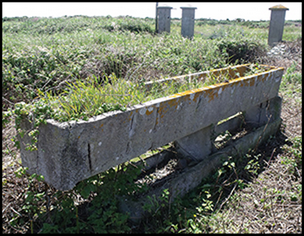The limited testimonies that describe life in Sylt labour camp highlight the severity of the atrocities committed, even in this early period. Former Helgoland camp prisoner Georgi Kondikov, for example, described Sylt as “the most terrible camp [which] everybody was afraid of”.
This reputation was attributed to the camp’s architecture—barracks exposed to the windy weather—and the treatment of prisoners by OT staff. Former Sylt prisoner Cyprian Lipinski explained how, during forced labour duties, “we were beaten with everything they could lay their hands on […] most of these beaten people died of wounds they had received”.
Each prisoner was assigned to a labour company and forced to undertake heavy construction work for 12 hours per day. They were inadequately dressed and undernourished. Daily rations consisted of black coffee for breakfast; a thin soup and a loaf of bread between five prisoners for lunch; and a relatively thicker soup with butter for dinner.
The OT did not administer medical treatment at Sylt: sick prisoners who were able to walk were sometimes permitted to visit the hospital at Norderney. One‐fifth of the camp’s inmates reportedly died between August 1942 and January 1943.
[…]
After the Second World War, the existence of Sylt became public knowledge through media reports, resulting in rumours about a death camp on Alderney. To quash these claims, the findings from Pantcheff’s 1945 investigation were published in 1981, but presented a less atrocious version of events compared to the original investigation.
Although the 1945 investigations highlighted the extent of atrocities at Sylt and identified those responsible, no prosecutions took place. Prisoner nationalities were simplified (reducing most victims to ‘Russian’) and, eventually, claims regarding the brutality were watered down. This was partly guided by the British Government’s desire to hand over the investigations to the Russian government in 1945, and to forget about the crimes perpetrated on the island, a view shared by many in the local government and population of Alderney.
(Emphasis added.)
This is somewhat unrelated, but as long as I am mentioning Axis concentration camps I’d like to take this opportunity to mention this archaeological analysis (alternative link) of several in southeast Poland that have been almost completely forgotten by time. It’s all very dense and technical, but is a good example of archaeologists taking on a challenge, if any of that’s your bag.


